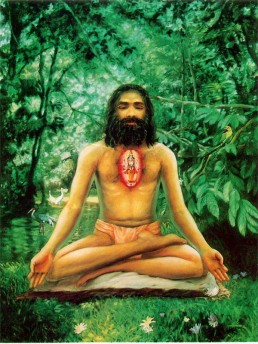Swami Chinmayananda
Swami Chinmayananda Commentary
After describing in detail the arrangement of the seat of meditation and how to sit there properly, Lord Krishna had thereafter explained what the meditator should do with his mind and intellect. He has also said that the mind should be made single-pointed by subduing all the activities of the sense-organs and the imagination. Adding more details to the technique of meditation, it is now said that the meditator should firmly hold his body in such a fashion that his vertebral column is completely erect. The head and the neck should be erect in this posture, which is geometrically perpendicular to the horizontal seat upon which the Yogi is firmly settling himself; it is pointedly indicated that he should hold his body “firmly.”
This term should not be misunderstood as holding the body in tension. “Firmly” here means that the body should not be held stiffly but relaxed, it must be held in such a manner that there should not be any tendency to swing forward and backward or sideways from right to left.
The seeker, having thus made himself ready for meditation, should “GAZE AT THE TIP OF THE NOSE.” This does not mean that an individual should, with half-opened eyes, deliberately turn his eye-balls towards the “tip of his own nose.” There are many seekers who have come to suffer physical discomforts, such as headaches, giddiness, exhaustion, tensions, etc., because they have tried to follow this instruction too literally. Shankara, in his commentary, has definitely given us the right direction. He says that the term here means only that the meditator, while meditating, should have his attention “AS THOUGH TURNED TOWARDS THE TIP OF HIS OWN NOSE.” That this interpretation is not a laboured and artificial intellectualism of the Acharya is clearly borne out by the next phrase in the second line.
NOT LOOKING AROUND — This instruction clearly shows what was in the mind of Krishna when he gave the instruction that the meditator should direct his entire attention towards the tip of his own nose — so that his concentration may not be dissipated and his mind may not wander all around. Where the eyes go, there the mind faithfully follows; this is the law. That is why, when an individual is confused, we find that his gaze is not steady. Many a time we judge another individual as behaving funny or suspicious, and in all such cases our evidence is nothing other than the unsteadiness in his gaze. Watch anyone who is indecisive and who is unsteady in his determination and you can immediately observe that the individual’s look is definitely unsteady and confusedly wandering.
MOREOVER:
Adi Sankara Commentary
Dharayan, holding; kaya-siro-girvam, the body (torso), head and neck; samam, erect; and acalam, still-movement is possible for one (even while) holding these erect; therefore it is specified, ‘still’-; sthirah, being steady, i.e. remaining steady; sampreksya, looking svam nasikagram, at tip of his own nose -looking at it intently, as it were; ca, and; anavalokayan, not looking; disah, around, i.e. not glancing now and then in various directions-. The words ‘as it were’ are to be understood because what is intended here is not an injunction for looking at the tip of one’s own nose! What then? It is the fixing the gaze of the eyes by withdrawing it from external objects; and that is enjoined with a veiw to concentrating the mind. [What is sought to be presented here as the primary objective is the concentration of mind. If the gaze be directed outward, then it will result in interrupting that concentration. Therefore the purpose is to first fix the gaze of the eyes within.] If the intention were merely the looking at the tip of the nose, then the mind would remain fixed there itself, not on the Self! In, ‘Making the mind fixed in the Self’ (25), the Lord will speak of concentrating the mind verily on the Self. Therefore, owing to the missing word iva (as it were), it is merely the withdrawl of the gaze that is implied by sampreksya (looking). Further, prasantatma, with a placid mind, with a mind completely at peace; vigata-bhih, free from fear sthitah, firm; brahmacari-vrate, in the vow of a celibate, the vow cosisting in serivce of the teacher, eating food got by beggin, etc.-firm in that, i.e. he should follow these; besides, mat-cittah, with the mind fixed on Me who am the supreme God; samyamya, by controlling; manah, the mind, i.e. by stopping the modifications of the mind; yuktah, through concentration, i.e. by becoming concentrated; asita, he should remain seated; matparah, with Me as the supreme Goal. Some passionate person may have his mind on a woman, but he does not accept the woman as his supreme Goal. What then? He accepts the king or Sive as his goal. But this one (the yogi) not only has his mind on Me but has Me as his Goal. After that, now is being stated the result of Yoga:
The Bhagavad Gita with the commentary of Sri Sankaracharya – Translated by Alladi Mahadeva Sastry
Holy Geeta – Commentary by Swami Chinmayananda
The Bhagavad Gita by Eknath Easwaran – Best selling translation of the Bhagavad Gita
The Bhagavad Gita – Translation and Commentary by Swami Sivananda
Bhagavad Gita – Translation and Commentary by Bhaktivedanta Swami Prabupadha
Srimad Bhagavad Gita Chapter 6 – Verse 13 – 6.13 samam kayasirogrivam – All Bhagavad Gita (Geeta) Verses in Sanskrit, English, Transliteration, Word Meaning, Translation, Audio, Shankara Bhashya, Adi Sankaracharya Commentary and Links to Videos by Swami Chinmayananda and others – 6-13

